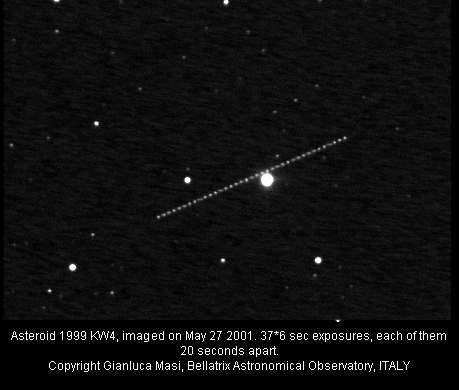
On 25 May 2001, the asteroid 1999 KW4 was traveling at about 4.8 million km from
us. This body belongs to the important class of Aten
asteroids (having their semimajor axes inside the Earth's orbit). Its period is the shortest we
know,
with the exception of the planet Mercury: 188 days.
We estimate its diameter to be 2, 4 km. It was discovered on May 20, 1999 by
LINEAR, a dedicated searching program, hunting for Near
Earth Objects (NEOs). The picture above is composed by 37, 6 sec long, CCD
exposures, taken at Bellatrix Observatory by Gianluca Masi, each of them
20 min apart. The body is well visible, moving very fast. The first frame (low,
on the left) was captured on May
27 at 22:27.16 UT.
Il 25 maggio 2001, l'asteroide 1999KW4 e' transitato a circa 4.8 milioni di km dalla terra. L'oggetto
e' del tipo Aten (ovvero di quelli che hanno semiasse maggiore dell'orbita
interno all'orbita terrestre). Il suo periodo di rivoluzione e' il piu' breve
conosciuto, se si esclude Mercurio: 188 giorni. L'oggetto e' stato scoperto il
20 maggio 1999 dal team di LINEAR, un programma dedicato alla ricerca
degli oggetti che possono transitare vicino alla terra. L'animazione e' composta
da 37 esposizioni, ciascuna con tempo di integrazione di 6 secondi, separate di
20 secondi l'una dall'altra, riprese dall'osservatorio Bellatrix da Gianluca
Masi . 1999 KW4 e' ben visibile e se ne apprezza il rapido movimento. La prima
immagine (in basso a sx) e' stata ottenuta il 27 maggio alle 22.27:16 TU.
1999 KW4 orbit - Orbita di 1999 KW4

Lightcurve - Curva di Luce
Processing all the images I captured, I've been able to build a lightcurve for this impressive asteroid. I will analyze further these results, in order to see if the duplicity can be inferred from this curve (this asteroid has been definitely confirmed by radar as a double body, after that photometry raised this possibility). The fading trend is dued to an eclipse; atthe beginning of the run, the sistem is probably recovering from another eclipse. Further details will be published soon. Please note that this is a preliminary curve, and more carefull calibration is under way. Every point comes from a CCD image and a total of 759 images were grabbed, from 22:14.08 UT (on May 27) to 01:16:06 UT (on May 28), each of them 19.15 sec apart.
Analizzando tutte le immagini raccolte, e' stato possibile realizzare una curva di luce per questo notevole oggetto. Ulteriori analisi permetteranno di stabilire se la duplicita' di questo corpo e' deducibile dal grafico, anche se certe caratteristiche sembrerebbero affermarlo (questo asteroide e' stato definitivamente riconosciuto come doppio alle osservazioni radar, dopo che gia' lo studio fotometrico aveva indicato questa possibilita'). La caduta di luce verso la fine della curva e' dovuta ad un'eclissi tra i due componenti; tra l'altro, all'inizio delle osservazioni, il sistema probabilmente e' in uscita da un'altra eclissi. Si noti che questa e' una curva preliminare e che una calibrazione piu' accurata e' in corso. Ciascun punto viene da un'immagine CCD e di queste ne sono state ottenute 759, tra le 22:14:08 TU (27 maggio) e le 01:16:06 UT (28 maggio), separate tra loro di 19.15 secondi.

Visitors of this page:
since May 29, 2001
Visitors of this site: since April 30, 1997